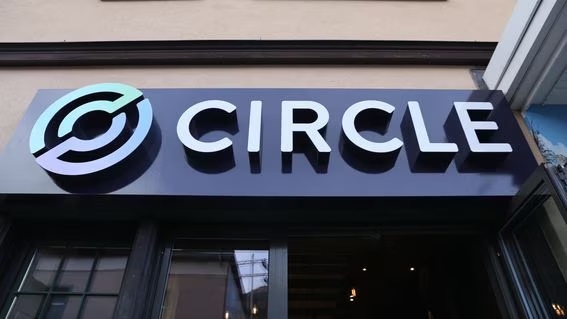
Circle Internet Group (CRCL), the issuer of the USDC stablecoin, hit a new all-time high stock price of $300, pushing its market capitalization to approximately $66 billion, surpassing the $61.3 billion circulating supply of USDC. This milestone, achieved just weeks after its June 5, 2025 IPO at $31 per share, reflects an 800%+ stock surge driven by investor confidence in Circle’s broader fintech ecosystem, including tokenization, corporate fund management, and international payments.
The U.S. Senate’s passage of the GENIUS Act, advancing stablecoin regulation, further fueled the rally, positioning USDC as a key player in DeFi, real-world assets, and cross-border transactions. However, some analysts caution that CRCL’s high valuation multiples, like a 216x net income P/E ratio, may signal a potential bubble, with growth hinging on USDC adoption and regulatory clarity. Meanwhile, Tether’s USDT retains a dominant 62% market share at $156 billion.
Circle’s stock surge to $300, valuing the company at $66 billion, reflects strong investor belief in its potential beyond USDC. Its fintech offerings—tokenization, corporate fund management, and international payments—are seen as high-growth areas, especially in DeFi and real-world asset (RWA) markets. The flip of USDC’s $61.3 billion market cap signals that investors value Circle’s infrastructure and future revenue streams more than the stablecoin’s current circulation.
Register for Tekedia Mini-MBA edition 19 (Feb 9 – May 2, 2026): big discounts for early bird.
Tekedia AI in Business Masterclass opens registrations.
Join Tekedia Capital Syndicate and co-invest in great global startups.
Register for Tekedia AI Lab: From Technical Design to Deployment (next edition begins Jan 24 2026).
The U.S. Senate’s GENIUS Act, passed recently, provides a clearer regulatory framework for stablecoins, boosting USDC’s credibility as a compliant, transparent alternative to Tether’s USDT. This could accelerate USDC adoption in institutional finance, cross-border payments, and Web3 applications. However, regulatory scrutiny could increase operational costs or limit innovation if compliance becomes overly restrictive.
Despite USDC’s growth, Tether’s USDT dominates with a $156 billion market cap (62% share). Circle’s valuation suggests investors expect it to challenge Tether, but USDT’s entrenched use in crypto trading pairs and offshore markets remains a hurdle. Circle’s focus on transparency and U.S. compliance gives it an edge in institutional markets, but Tether’s opacity appeals to privacy-focused users, deepening the divide.
CRCL’s 216x P/E ratio raises bubble concerns. If USDC adoption or Circle’s fintech ventures underperform, the stock could face sharp corrections. High valuations may pressure Circle to deliver consistent growth, potentially leading to aggressive expansion or acquisitions. USDC’s rise strengthens the stablecoin sector’s legitimacy, encouraging mainstream adoption in payments, remittances, and DeFi. However, it could concentrate market power among a few players, raising systemic risk concerns.
Stablecoin growth may draw more regulatory attention globally, impacting smaller issuers or decentralized stablecoins. USDC/Circle represents the compliant, regulated side, appealing to institutions, governments, and traditional finance. Its transparency (e.g., monthly attestations) aligns with U.S. regulatory demands but limits appeal in privacy-centric markets.
USDT/Tether thrives in less-regulated environments, popular among crypto traders and offshore users. Its opacity and questionable reserve backing create trust issues but maintain its dominance in trading volume. Circle targets institutional adoption (e.g., BlackRock’s tokenized funds, Visa’s payment integrations), positioning USDC as a bridge between TradFi and DeFi. This caters to large-scale, regulated use cases.
Tether serves retail-heavy crypto markets, particularly in regions with limited banking access, where USDT acts as a de facto digital dollar. USDC’s centralized model, backed by Circle and regulated reserves, contrasts with decentralized stablecoins like DAI or algorithmic stablecoins. Centralized stablecoins dominate due to stability and trust but face criticism for custodial risks and regulatory dependence.
Decentralized alternatives struggle with scalability and volatility but appeal to crypto purists prioritizing censorship resistance. CRCL’s $66 billion valuation reflects speculative optimism about Circle’s future, not just USDC’s current $61.3 billion supply. This disconnect could widen if growth falters, creating a divide between investor expectations and operational reality.
Tether’s lack of public valuation (private company) obscures its financial health, leaving the market to speculate on its reserves and profitability. Circle’s U.S.-focused compliance aligns with Western regulatory trends, giving it an edge in developed markets but limiting penetration in regions with restrictive crypto policies or distrust of U.S. oversight.
Tether’s global reach, especially in Asia and emerging markets, stems from its regulatory arbitrage and accessibility, but it faces risks from international crackdowns. Circle’s $300 ATH and market cap flip of USDC underscore its rising influence in the stablecoin and fintech sectors, fueled by regulatory clarity and institutional interest. However, the divide between compliant (USDC) and less-regulated (USDT) stablecoins, centralized vs. decentralized models, and speculative valuations vs. fundamentals will shape the industry’s future.
Circle’s success hinges on scaling USDC adoption and delivering on its fintech vision, while navigating regulatory and competitive pressures. The broader crypto market must balance innovation with stability to avoid systemic risks as stablecoins grow.



